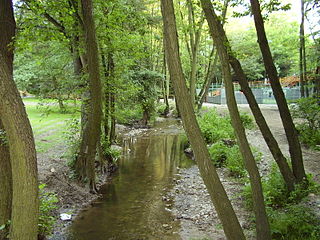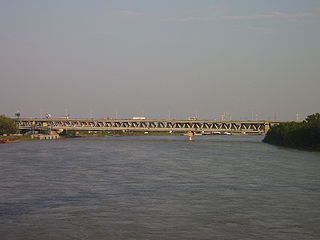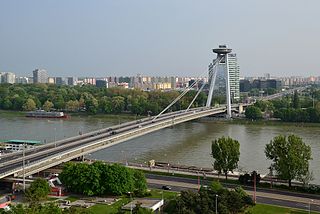
Ružinov is a borough of Bratislava, the capital of Slovakia, located in the Bratislava II district. It is the city's second most populated borough, housing over 70,000 inhabitants and its Nivy neighborhood is the place of the emerging new city center of Bratislava. Ružinov features extensive residential areas, as well as major industrial facilities and transport infrastructure including the Milan Rastislav Štefánik international airport and the D1 motorway.

The Old Town of Bratislava is the historic center and one of the boroughs of Bratislava, in the Bratislava Region of Slovakia. It is coextensive with the smallest Slovak administrative district by area, Bratislava I. It contains the small, but preserved medieval city center, Bratislava Castle and other important landmarks. Bratislava's Old Town is known for its many churches, the Bratislava Riverfront and cultural institutions, it is also the location of most of the foreign states embassies and important Slovak institutions including the National Council of the Slovak Republic; the Summer Archbishop's Palace, seat of the Government of Slovakia; and Grassalkovich Palace, seat of the President of Slovakia.

Bratislava I is a district in the city of Bratislava. It is identical with its sole borough, Bratislava's Old Town. With an area of 10 square kilometers, it is the smallest district of Slovakia. It is completely surrounded by other Bratislava districts: Bratislava II, Bratislava III, Bratislava IV and Bratislava V.
Apollo Arena Bratislava, also known as the Danube Arena, was a proposed a multi-use indoor arena in Bratislava, Slovakia. It was to be used mostly for ice hockey and basketball matches, as well as concerts and similar events. The 2011 IIHF World Championship was to be held in this arena, but later it was decided to renovate the old Ondrej Nepela Arena rather than to build a new stadium, as the city did not possess land in the proposed area between Apollo Bridge and Harbour Bridge on the right bank of Danube river. The arena was supposed to have a capacity of 13,600 people. It was named after the former Apollo refinery, destroyed by carpet bombing by the Allies in the Second World War, which was lying nearby on the left bank of Danube.

The Bratislava Region is the wealthiest and economically most important region in Slovakia, despite being the smallest by area and having the second smallest population of the eight Slovak regions. The most important governmental institutions, including the Ministry of Finance and the central bank, as well as many private companies have their headquarters in Bratislava. More than 75% of Bratislava's population works in the service sector, mainly composed of trade, banking, IT, telecommunication industry, tourism and others. The Bratislava Stock Exchange (BSSE), the organiser of the public market of securities, was founded on March 15, 1991.

The Port of Bratislava is a major port on the river Danube and — in a wider sense — on the Rhine-Main-Danube waterway, located in Bratislava, the capital of Slovakia. It is a universal inland port consisting of two parts, a cargo port and a passenger port. The former is a key facility for Slovakia's economy as the largest of three international ports in Slovakia, the others being in Komárno and Štúrovo. The port lies at the strategic intersection of the Rhine-Main-Danube Canal with the Baltic-Adriatic Corridor, part of the Trans-European Transport Networks, and it is located near two major ports: Port of Vienna and Port of Budapest.

Vydrica(Hungarian: Vödric, German: Weidritz) is a small 17 km long river in south-western Slovakia, which originates in the Little Carpathians mountains at about 450 m AMSL and flows into the Danube through the capital Bratislava.

Bratislava is the capital city and the cultural and economic centre of Slovakia. It is home to several museums and galleries, including the Slovak National Museum and the Slovak National Gallery.

Mlynská dolina is a neighborhood of Karlova Ves borough of Bratislava, the capital of Slovakia. It is located in the Bratislava IV district. Geographically and historically it constitutes a much larger area of the entire valley of the river Vydrica, including its upper part located in the Little Carpathians mountains and the area of Patrónka.
Bratislava's geographical position in Central Europe has long made Bratislava a natural crossroads for international trade traffic. Various ancient trade routes, such as the Amber Road and the Danube waterway have crossed the territory of today's Bratislava. Today Bratislava is a road, railway, waterway and airway hub.

Bratislava is the capital of Slovakia. With a population of about 425,000, it is one of the smaller capitals of Europe but still the country's largest city. The greater metropolitan area is home to more than 650,000 people. Bratislava is in southwestern Slovakia, occupying both banks of the River Danube and the left bank of the River Morava. Bordering Austria and Hungary, it is the only national capital that borders two sovereign states.

The parks and gardens in Bratislava have formed a part of the landscape of the capital of Slovakia since the Middle Ages. Some of the historical gardens of Bratislava had such architectonic value that they were widely known outside of the city and well beyond the borders of the Kingdom of Hungary. Perhaps the best known garden in the city's history was the renaissance Pálffy Garden, with its famous landmark, a centuries-old linden tree encased in a wooden terrace frame, seven floors in height.

Sihoť is the largest river island on the Danube in Bratislava, the capital of Slovakia, located in the district of Karlova Ves. The island lies between the main flow of the Danube to the north and the parallel channel Karloveské rameno to the south, between Devínska cesta in Bratislava and the Austrian border. It contains a culturally protected water source supplying tap water to a large portion of Bratislava citizens, as well as numerous nearby villages.
The following is a timeline of the history of the city of Bratislava, Slovakia.






























